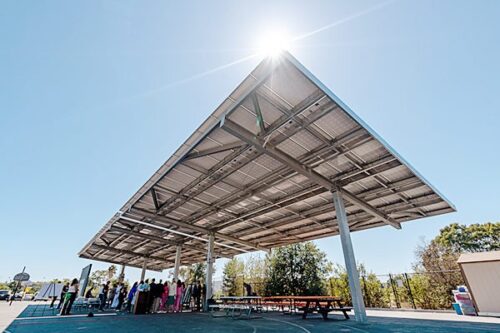
A revolutionary way to easily value resilience for any facility
How the Clean Coalition's VOR123 methodology can be applied to any facility, whether resilience is provisioned onsite or from Community Microgrids.
At a time when everyone is increasingly aware of the growing need for energy resilience, even professional facilities managers still find it elusive to quantify the significant value of that resilience. The absence of a value-of-resilience (VOR) standard has remained a major gap in the market for Community Microgrids, which provide resilience across community-scale grid areas, and Solar Microgrids, which provide resilience for individual facilities, like schools (often used as emergency centers), fire stations, and hospitals.
A standardized VOR will allow all stakeholders to effectively consider VOR when analyzing microgrid economics – making microgrid economics far more favorable. The increased valuation, in turn, will accelerate the proliferation of microgrids throughout the country and well beyond.
Normalizing the value-of-resilience at any facility
In 2020 the Clean Coalition, a California nonprofit, developed a straightforward value-of-resilience methodology, VOR123, which makes it possible to quantify the value of renewables-driven resilience at any facility type, in any location.
The key to the VOR123 methodology is tiering electricity loads – because different loads have different values. Refrigerators that keep food or medicine from spoiling, communications systems used by first responders, and water systems for fighting fires are life-sustaining and critical to keep online, whereas most loads are highly discretionary with little impact from going offline for periods of time.
The VOR123 methodology categorizes loads into the following three tiers, regardless of facility type or location:
- Tier 1: Critical loads are life-sustaining and/or mission-critical that should be configured for 100% resilience.
- Tier 2: Priority loads should be maintained as long as doing so does not threaten the ability to maintain Tier 1 loads.
- Tier 3: Discretionary loads should be maintained only when doing so does not threaten the ability to maintain Tier 1 and Tier 2 loads.
Facilities vary in the percentage of their total load that is deemed critical and priority. A fire station typically has a far lower critical and priority load percentage than a hospital, for example, but regardless, the key is for each facility to determine for itself what percentage of its total load is critical and priority. While these percentages do vary, the Clean Coalition has found that the majority of facilities have the following approximate load tier percentages:
- Tier 1: Usually about 10% of a facility’s total load.
- Tier 2: Usually about 15% of the total load.
- Tier 3: The remaining load and usually about 75% of the total load.

Using these common tier levels, the Clean Coalition developed standard Solar Microgrid sizing for California facilities, based on deploying enough solar to net-zero a site with 200 kWh of energy storage for each 100 kW of solar:
- Tier 1 loads: Online 100% of the time.
- Tier 2 loads: Online at least 80% of the time.
- Tier 3 loads: Online at least 25% of the time.
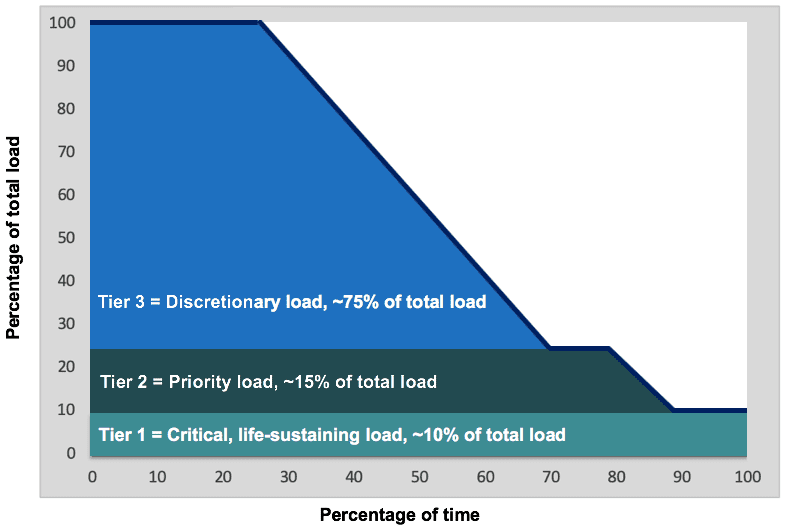
Tiering loads makes it simple to determine the VOR for any facility type, whether it’s a school, a fire station, a home, or any other type of facility. From a VOR perspective, the only difference between facilities is the relative Tier 1, Tier 2, and Tier 3 load allocations.
Based on this tiering system, the Clean Coalition arrived at 25% as the typical VOR123 adder that a site should be willing to pay for indefinite renewables-driven backup power to critical loads – along with renewables-driven backup for the rest of the loads for significant percentages of time. This figure was validated using four different approaches. Some real-world projects that VOR123 has been applied to, such as the Solar Microgrids for the Santa Barbara Unified School District (SBUSD), will receive this tremendous resilience value for free.
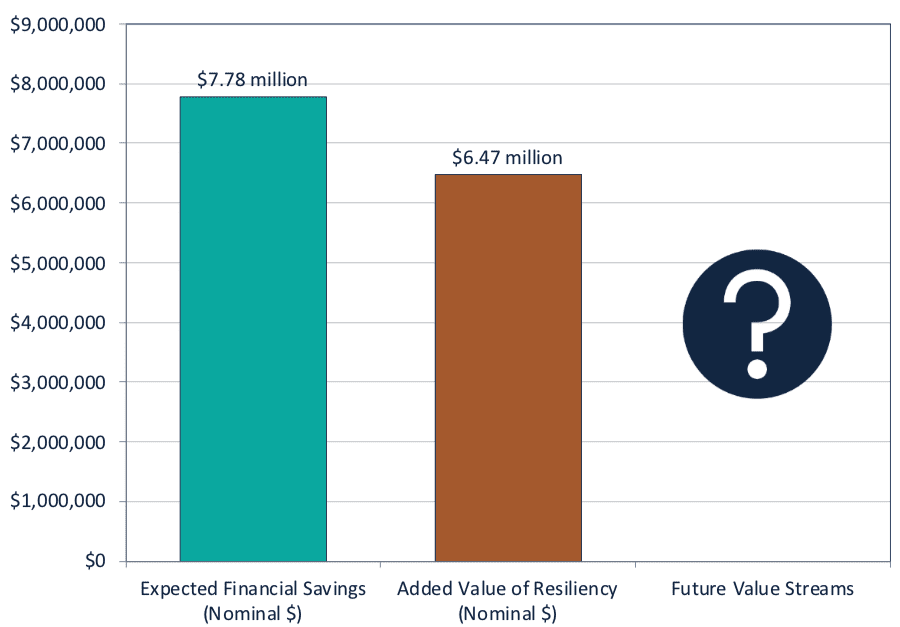
Once the load tiers are established at a facility, it is key to manage the loads to ensure that a facility realizes the full value-of-resilience. A straightforward load management approach uses a critical load panel (CLP) to maintain Tier 1 loads indefinitely while toggling other loads as appropriate. Tier 2 loads can be force-ranked and toggled accordingly via a smart CLP, while Tier 3 loads can be toggled as a group through the main service board, depending on energy availability at any given time. The following circuit flow diagram reflects the CLP approach designed for the Solar Microgrid at San Marcos High School, one of the SBUSD’s comprehensive high schools:

Also key is optimizing batteries for economics and resilience. To optimize economic performance while provisioning indefinite renewables-driven backup power to critical loads, a Solar Microgrid needs to always be ready to operate in two fundamental modes:
- Normal grid-connected operations: In normal operations, with the exception of a minimum battery energy storage system (BESS) state of charge reserved for resilience (SOCr), the entire usable BESS energy capacity should be available for daily cycling in pursuit of economic optimization, as illustrated in the figure below.
- Emergency grid-outage operations: In emergency operations, during grid outages, the site is entirely powered by the Solar Microgrid, with the solar and BESS being dedicated to serving onsite loads according to the specified tiering prioritization.

A site must be able to override SOCr settings to between 0% and 100% of the daily usable BESS energy capacity. For example, if preferences increase for everyday economic optimization, then the site can set lower SOCr levels. Conversely, in the face of coming storms and/or power outage warnings, the site can set higher SOCr levels to prepare for the increased likelihood of grid outages and associated energy resilience needs.
More details on the VOR123 methodology can be found in this webinar presentation.
Provisioning VOR123 from a Community Microgrid
To provide resilience to a community, we need to go beyond Solar Microgrids at individual facilities – we need to complement those Solar Microgrids with other distributed energy resources to ensure that Critical Community Facilities (CCFs) such as those supporting emergency response operations like fire, sheltering, and medical are provisioned with at least enough energy to support their Tier 1 loads. Essentially, this means that Community Microgrids are configured such that Tier 1 facilities can always be provisioned with enough energy to support their Tier 1 loads.
Fortunately, the same VOR123 principles that work for an individual facility can be applied to a larger grid area. Community Microgrids have the same solar+storage ratios as individual Solar Microgrids. Facilities in a grid area can be tiered in a similar manner to loads, based on how critical a facility is to a community. Additionally, for true CCFs, the Community Microgrid costs should be ratebased, on a cost-of-service basis, just like the cost of every other grid asset that serves the community at large.
A perfect example of how a Community Microgrid can provide resilience to a grid area comes from the Goleta Load Pocket (GLP), a grid-constrained, disaster-prone 70-mile stretch of California coastline in the Santa Barbara area that is surrounded by severe risks from fires, landslides, and earthquakes. The GLP lies at the northwestern corner of the Southern California Edison (SCE) service area and gets the vast majority of its energy from one Ҭset of transmission lines, hung on the same transmission towers and routed through 40 miles of mountainous terrain.

The 66 kilovolt (kV) distribution feeder #4311, at the core of the GLP, illustrates how a Community Microgrid could work in one section of this region. The 4311 feeder serves a number of critical community facilities: the airport; multiple fire stations; the University of California Santa Barbara (UCSB), which serves as the main sheltering site for all of Santa Barbara County; critical water facilities; and Direct Relief, a major disaster response nonprofit.
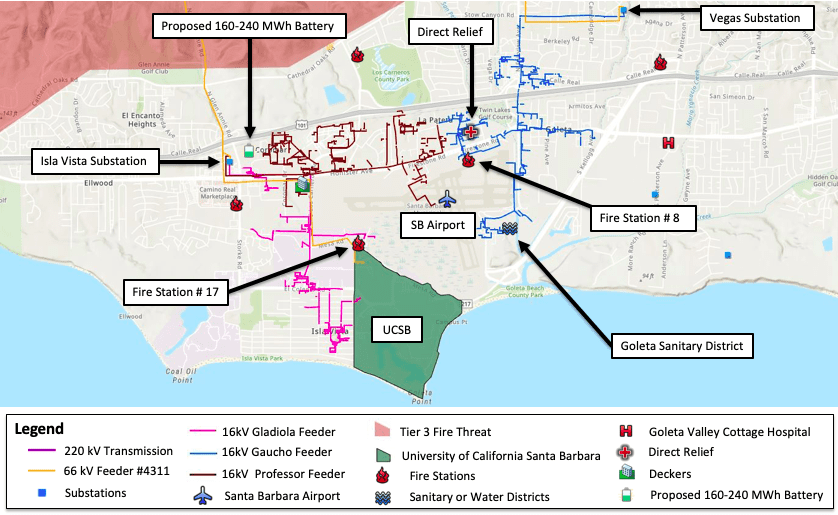
As shown in the diagram below, a Community Microgrid could incorporate these critical community facilities. The Community Microgrid could also include the Deckers headquarters, which is not a CCF itself but could oversize a Solar Microgrid that in turn could be harnessed during a grid outage to support the airport and other core CCFs. If the grid were isolated at the grid isolation switch shown to the left of the Deckers facility, a Solar Microgrid at Deckers could help provision 100% resilience to the Santa Barbara Airport’s primary critical loads: the air traffic control tower (ATC) and runway lights.

In another section of the GLP, work is already progressing on some of the Solar Microgrid building blocks for the Montecito Community Microgrid, with the Montecito Fire District and the Montecito Union School moving forward with Solar Microgrids. The Montecito Water District has massive solar siting opportunity, so adding that facility would bring added resilience to the immediately adjacent Fire District, which has far less solar siting opportunity.
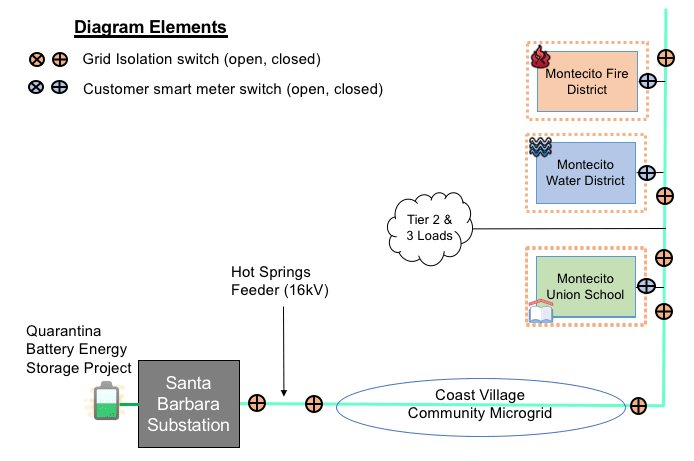
To determine which loads to keep online during an outage, the facilities within a grid area can be tiered in much the same way that the loads are tiered at a single facility – with Tier 1 facilities being the most critical to a community. The top emphasis will be to provision 100% resilience for Tier 1 loads at Tier 1 facilities, followed by the Tier 1 loads at other facilities and Tier 2 loads at CCFs.
The VOR123 approach provides a straightforward policy implementation opportunity as well, because aside from ratebasing Community Microgrid investments that are needed to serve Tier 1 facilities – CCFs – other facilities can subscribe to guaranteed energy levels of Community Microgrid service with subscription fees or tariffs, accordingly. For example, a local bank might subscribe to 100 kWh of guaranteed daily energy from a Community Microgrid in order to satisfy its daily average Tier 1 load for running a data center and other mission-critical operations; the fee or tariff will be determined by the cost-of-service for provisioning such Community Microgrid resilience.

Community Microgrid fees and/or tariffs can be set to provision minimum guaranteed levels of daily energy, while participating subscribers will generally be provisioned with much higher levels of resilience – just as is the case with Solar Microgrids at individual facilities with Tier 2 loads supported at least 80% of the time.
Realizing the potential of VOR123
The VOR123 methodology is a game-changing approach for both Solar Microgrids and Community Microgrids. VOR123 is simple and straightforward, with unparalleled effectiveness, including for standardizing value – and cost-recovery market mechanisms based on standard utility industry cost-of-service practices. The adoption of VOR123 will unleash the proliferation of renewables-driven microgrids – at both the facility and the community levels.
This article was originally published on Energy Centraland is posted here by permission.

